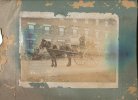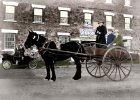Hello, this is my first post here!
I don't know if it helps but the tree in the upper left corner is most probably an European larch (Larix decidua) which is grown for timber in Scotland.

The tree shown on the
contemporary photo of the alleged location is also an European larch and you can see several larches in the distance (the yellow trees between the evergreen pines).

Larch needles turn yellow and are shed in fall as seen in this photo.
Larches are easily recognized by their needle-bearing short shoots grouped along their thin often pendulous branches. After needles fall the short shoots look like small beads on a string. Additionally there are the 2-4cm large larch cones, visible in the photo as larger egg shaped black dots.
If the branch on the right is a larch, the 'UFO' photo was taken during the growing season, likely in summer as the larch needles are rendered completely black as they would have been dark green in real life. The tips of the branches are bare and likely dead.
I do not know when larches turn yellow in Scotland, probably September. But this gives a limit to the season the photo could have been taken.
I am unsure about the branch in the middle. It looks odd. It might belong to the same larch tree but I cannot discern any branches with short shoots or needles. This may be due to the high contrast between dark needles and the bright sky but it still looks remarkably different to the branch on the left.

An alternative would be weeping birch (Betula pendula) but it branches differently. Unfortunately the quality of the photo is not good enough to give a definite answer.
The most interesting plant however is the "shrub' on the fence post on the lower left. It puzzled me for a long time because I can hardly think of a Scottish plant with such growth pattern.

It almost looks like an old palm frond. At first I thought in might be some sort of reed but what we see are probably dead branches if a tree that's either tilted 45° or 135° and almost upside down. In this case the dead branches would originally have pointed upward while the crown still has foliage and is at the base of the fence post. It could be a pine. But I am really not sure, maybe this is something entirely different and not a plant at all.
One last hypothesis - this is a close-up of the shoot of a Scot's pine (Pinus sylvestris) and the horizontal reed-like appendages which appear to emerge from a trunk are the pine's needles.


This would however mean that the entire 'plant' at the fence post is only about 10-20cm, long. But if this branch is right in front of the camera, how can the rest also be in focus?



